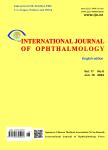The diluted atropine for inhibition of myopia progression in Korean children
The diluted atropine for inhibition of myopia progression in Korean children作者机构:Department of Ophthalmology National Medical Center Department of Ophthalmology and Visual Science Seoul St.Mary's Hospital College of Medicine the Catholic University of Korea
出 版 物:《International Journal of Ophthalmology(English edition)》 (国际眼科杂志(英文版))
年 卷 期:2018年第11卷第10期
页 面:1657-1662页
核心收录:
学科分类:1002[医学-临床医学] 100212[医学-眼科学] 10[医学]
主 题:atropine Korean children myopia progression
摘 要:AIM:To evaluate the efficacy and safety of three different concentrations of diluted atropine for the control of myopia in Korean children,and to assess the risk factors associated with rapid myopia ***:A total of 285 children,with refractive errors within the range of-6 diopters(D)between 5 and 14 years of age were *** using 0.01%,or 0.025%,or 0.05% atropine,for about 1y,changes in refraction,axial lengths and frequency of adverse events were *** regression analyses were performed to evaluate the risk factors associated with rapid myopia ***:The changes in the mean spherical equivalent values were -0.134 D/mo in the before atropine group,-0.070 D/mo in the 0.01% atropine group,-0.047 D/mo in the 0.025% atropine group,and -0.019 D/mo in the 0.05% atropine group,with significant differences between the groups(P〈0.001).The axial elongation was 0.046 mm/mo,0.037 mm/mo,0.025 mm/mo,and 0.019 mm/mo respectively,with significant differences between the groups(P=0.003).The incidence of photophobia and near vision difficulty was not different among the three atropine groups(P=0.425and P=0.356,respectively).Multivariate logistic regression analyses showed that only highly myopic parents were a significant predictive factor of rapid myopia progression in Korean children(odds ratio,8.155;95% confidence interval,3.626-18.342;P〈0.001).CONCLUSION:Treatment with 0.01%,0.025% and 0.05% atropine solution inhibits myopia progression in Korean children in a dose-dependent *** with highly myopic parents preferentially shows a rapid myopia progression rate.



